.
On March 25, the MESSENGER spacecraft completed its 4,000th orbit of Mercury, and the lowest point in its orbit continues to move closer to the planet than ever before. The orbital phase of the MESSENGER mission, which was originally designed to collect data for one Earth year, just completed its fourth year of operation around Mercury. The mission has received a final extension to allow scientists to gather specific low-altitude data over an additional several weeks.
"When we completed our first Mercury flyby on January 14, 2008, after months of preparations and testing, we were amazed and perhaps even a little skeptical when the science team told us that the orbital phase could be characterized as two flybys of data collection every Earth day (and eventually three per day starting in April 2012)," said MESSENGER Mission Operations Manager Andy Calloway, of the Johns Hopkins University Applied Physics Laboratory (APL) in Laurel, Md. "Now that we have surpassed 4,000 orbits and more than 17 Mercury years since Mercury orbit insertion, we know just what was meant by that prediction."
"Thanks to requisite optimization tools and techniques -- such as the SciBox science planning tool, customized downlink rate stepping during Deep Space Network contacts, and automated prioritization of data playback with the use of the Consultative Committee for Space Data Systems (CCSDS) file delivery protocol, to name just a few -- we have captured more than 275,000 images and downlinked more than four Earth years of data from our comprehensive suite of instruments," he continued. "MESSENGER really is the little spacecraft that could."
Last week, mission operators conducted the first of five final adjustments to MESSENGER's orbit to delay the inevitable impact onto the surface of Mercury. During these last several weeks (for which the project uses the term XM2' hover campaign), the spacecraft is maintaining an unprecedented range of periapsis altitudes between 6 and 38 kilometers (3.7 to 24 miles) above Mercury's surface, allowing scientists to continue to collect and return novel data until the final moments before impact.
"The MESSENGER milestone of 4,000 orbits around Mercury in just over four years is a testament to the talent and dedication of the teams that designed, built, and operated a spacecraft for which the original plan was to complete about 740 orbits during a single year after Mercury orbit insertion," said APL's James McAdams, MESSENGER's Mission Design Lead Engineer. "An exemplary science team and supportive NASA sponsorship and oversight have made the most of the mission extensions, leading to numerous new insights into the processes that formed and subsequently transformed our solar system's nearest planet to the Sun."
.
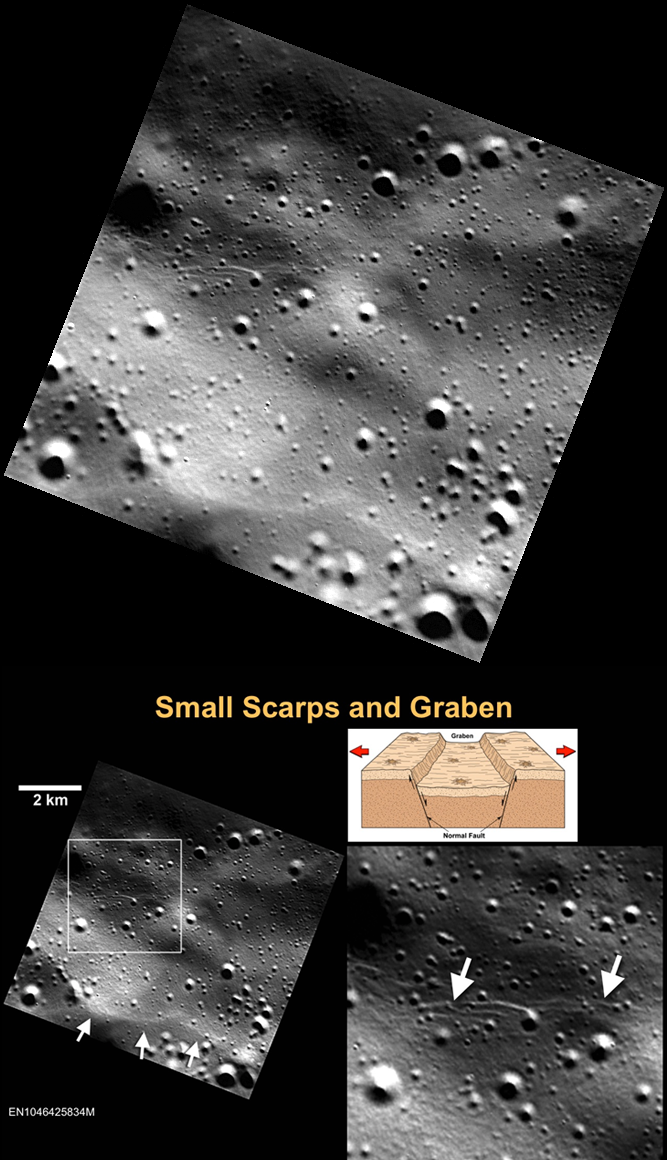
Of Interest: Small graben, narrow linear troughs, have been found associated with small scarps (bottom left, white arrows) on Mercury and the Moon. These graben (bottom right, white arrows) likely resulted from the bending and extension of the upper crust in response to scarp formation (bottom illustration) and are only tens of meters wide. On the basis of the rate of degradation and infilling of small troughs on the Moon by continuous meteoroid bombardment, small lunar graben and their associated scarps are less than 50 Myr old! It is likely that Mercury’s small graben and their associated scarps are younger still, because the cratering rate on Mercury is greater than on the Moon.
This image was acquired as part of the MDIS low-altitude imaging campaign. During MESSENGER's second extended mission, the spacecraft makes a progressively closer approach to Mercury's surface than at any previous point in the mission, enabling the acquisition of high-spatial-resolution data. For spacecraft altitudes below 350 kilometers, NAC images are acquired with pixel scales ranging from 20 meters to as little as 2 meters.
.
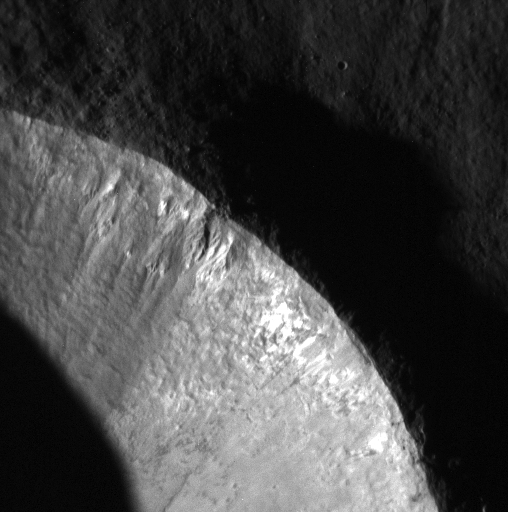
Of Interest: Another look at the fresh impact crater seen here is revealed in this image. This time the image is showing incredible detail of erosional patterns on the crater wall and a glimpse of boulders just outside the crater rim.
This image was acquired as a high-resolution targeted observation. Targeted observations are images of a small area on Mercury's surface at resolutions much higher than the 200-meter/pixel morphology base map. It is not possible to cover all of Mercury's surface at this high resolution, but typically several areas of high scientific interest are imaged in this mode each week.
Quelle: NASA
.
Update: 17.04.2015
.
NASA Spacecraft Achieves Unprecedented Success Studying Mercury
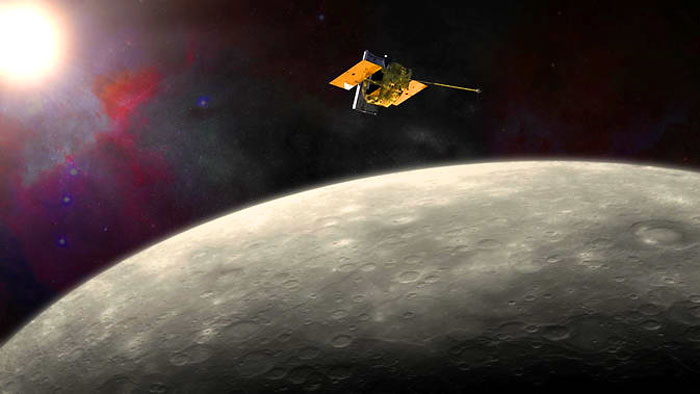
NASA’s MErcury Surface, Space ENvironment, GEochemistry, and Ranging (MESSENGER) spacecraft traveled more than six and a half years before it was inserted into orbit around Mercury on March 18, 2011.
After extraordinary science findings and technological innovations, a NASA spacecraft launched in 2004 to study Mercury will impact the planet’s surface, most likely on April 30, after it runs out of propellant.
NASA’s MErcury Surface, Space ENvironment, GEochemistry, and Ranging (MESSENGER) spacecraft will impact the planet at more than 8,750 miles per hour (3.91 kilometers per second) on the side of the planet facing away from Earth. Due to the expected location, engineers will be unable to view in real time the exact location of impact.
On Tuesday, mission operators in mission control at the Johns Hopkins University Applied Physics Laboratory (APL) in Laurel, Maryland, completed the fourth in a series of orbit correction maneuvers designed to delay the spacecraft’s impact into the surface of Mercury. The last maneuver is scheduled for Friday, April 24.
"Following this last maneuver, we will finally declare the spacecraft out of propellant, as this maneuver will deplete nearly all of our remaining helium gas,” said Daniel O’Shaughnessy, mission systems engineer at APL. “At that point, the spacecraft will no longer be capable of fighting the downward push of the sun's gravity.”
Although Mercury is one of Earth’s nearest planetary neighbors, little was known about the planet prior to the MESSENGER mission.
“For the first time in history we now have real knowledge about the planet Mercury that shows it to be a fascinating world as part of our diverse solar system,” said John Grunsfeld, associate administrator for the Science Mission Directorate at NASA Headquarters in Washington. “While spacecraft operations will end, we are celebrating MESSENGER as more than a successful mission. It’s the beginning of a longer journey to analyze the data that reveals all the scientific mysteries of Mercury.”
The spacecraft traveled more than six and a half years before it was inserted into orbit around Mercury on March 18, 2011. The prime mission was to orbit the planet and collect data for one Earth year. The spacecraft’s healthy instruments, remaining fuel, and new questions raised by early findings resulted in two approved operations extensions, allowing the mission to continue for almost four years and resulting in more scientific firsts.
One key science finding in 2012 provided compelling support for the hypothesis that Mercury harbors abundant frozen water and other volatile materials in its permanently shadowed polar craters.
Data indicated the ice in Mercury's polar regions, if spread over an area the size of Washington, would be more than two miles thick. For the first time, scientists began seeing clearly a chapter in the story of how the inner planets, including Earth, acquired water and some of the chemical building blocks for life.
A dark layer covering most of the water ice deposits supports the theory that organic compounds, as well as water, were delivered from the outer solar system to the inner planets and may have led to prebiotic chemical synthesis and, thusly, life on Earth.
“The water now stored in ice deposits in the permanently shadowed floors of impact craters at Mercury’s poles most likely was delivered to the innermost planet by the impacts of comets and volatile-rich asteroids,” said Sean Solomon, the mission’s principal investigator, and director of Columbia University's Lamont-Doherty Earth Observatory in Palisades, New York. “Those same impacts also likely delivered the dark organic material.”
In addition to science discoveries, the mission provided many technological firsts, including the development of a vital heat-resistant and highly reflective ceramic cloth sunshade that isolated the spacecraft’s instruments and electronics from direct solar radiation – vital to mission success given Mercury’s proximity to the sun. The technology will help inform future designs for planetary missions within our solar system.
“The front side of the sunshade routinely experienced temperatures in excess of 300° Celsius (570° Fahrenheit), whereas the majority of components in its shadow routinely operated near room temperature (20°C or 68°F),” said Helene Winters, mission project manager at APL. “This technology to protect the spacecraft’s instruments was a key to mission success during its prime and extended operations.”
The spacecraft was designed and built by APL. The lab manages and operates the mission for NASA's Science Mission Directorate. The mission is part of NASA's Discovery Program, managed for the directorate by the agency's Marshall Space Flight Center in Huntsville, Alabama.
.
NASA Celebrates MESSENGER Mission Prior to Surface Impact of Mercury
NASA's highly successful MErcury Surface, Space ENvironment, GEochemistry, and Ranging (MESSENGER) spacecraft is coming to the end of its operations. Mission engineers predict that the probe -- out of fuel and under gravity's spell -- will impact Mercury on April 30 at more than 8,750 miles per hour (3.91 kilometers per second).
The spacecraft launched on August 3, 2004, and travelled more than six and a half years before it was inserted into orbit about Mercury on March 18, 2011. The original plan was to orbit the planet for one Earth year, collecting data to answer six critical questions. But new questions raised by early findings motivated two extensions of orbital operations for a total of three more years. Moreover, through a series of technological innovations, MESSENGER's engineers devised a way to save fuel early on and leverage helium gas later, paving the way for a final one-month extension that enabled mission scientists to continue to acquired novel, low-altitude measurements of the planet closest to the Sun.
"MESSENGER had to survive heating from the Sun, heating from the dayside of Mercury, and the harsh radiation environment in the inner heliosphere, and the clearest demonstration that our innovative engineers were up to the task has been the spacecraft's longevity in one of the toughest neighborhoods in our Solar System," said MESSENGER Principal Investigator Sean Solomon, director of Columbia University's Lamont-Doherty Earth Observatory. "Moreover, all of the instruments that we selected nearly two decades ago have proven their worth and have yielded an amazing series of discoveries about the innermost planet."
"Although Mercury is one of Earth's nearest planetary neighbors, astonishingly little was known when we set out," Solomon continued. "MESSENGER has at last brought Mercury up to the level of understanding of its sister planets in the inner Solar System. Of course, the more we learn, the more new questions we can ask, and there are ample reasons to return to Mercury with new missions."
In a briefing at NASA Headquarters today, MESSENGER scientists and engineers ticked off the top science findings and technological innovations from the mission. Near the top of the list of science accomplishments is having provided compelling support for the hypothesis that Mercury harbors abundant water ice and other frozen volatile materials in its permanently shadowed polar craters.
"The water now stored in ice deposits in the permanently shadowed floors of impact craters at Mercury's poles most likely was delivered to the innermost planet by the impacts of comets and volatile-rich asteroids," says Solomon. "Those same impacts also likely delivered the material in the dark layer discovered by MESSENGER to cover most polar deposits and interpreted, on the basis of its sublimation temperature and low reflectance, to be carbonaceous. By this interpretation, Mercury's polar regions serve as a witness plate to the delivery to the inner solar system of water and organic compounds from the outer solar system, a process that much earlier may have led to prebiotic chemical synthesis and the origin of life on Earth. MESSENGER's findings have made Mercury an even more interesting body for future exploration than before our mission."
The technological innovations that grew out of the MESSENGER mission are equally impressive, said MESSENGER Project Manager Helene Winters and MESSENGER Mission Systems Engineer Daniel O'Shaughnessy, both of the Johns Hopkins University Applied Physics Laboratory in Laurel, Md.
Together, they presented the top 10 technology innovations, which included the development of MESSENGER's first line of thermal defense, a heat-resistant and highly reflective ceramic cloth sunshade that isolates the spacecraft's instruments and electronics from direct solar radiation.
"The front side of the sunshade routinely experiences temperatures in excess of 300 degrees Celsius (570 degrees Fahrenheit), whereas the majority of components in its shadow routinely operate near room temperature (20 degrees Celsius or 68 degrees Fahrenheit)," Winters explained. "The sunshade is extremely effective at isolating most of the vehicle from the Sun's radiation, but reflected infrared radiation from Mercury greatly influences the temperatures of MESSENGER's components behind the sunshade. The influence of Mercury is effectively managed with careful selection of vehicle orientation, to balance heating across the spacecraft, as well as an intricate system of heat pipes and radiators."
On April 14, mission operators at APL completed the fifth in a series of orbit correction maneuvers designed to delay MESSENGER's impact into Mercury. The last such maneuver is scheduled for April 24.
"Following this last maneuver, we will finally declare MESSENGER out of propellant, as this maneuver will deplete nearly all of our remaining helium gas," O'Shaughnessy said. "At that point, the spacecraft will no longer be capable of fighting the downward push of the Sun's gravity. After studying the planet intently for more than four years, MESSENGER's final act will be to leave an indelible mark on Mercury, as the spacecraft heads down to an inevitable surface impact."
.
Aus dem Archiv:
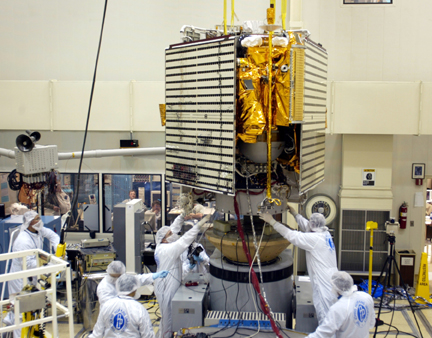
Engineers prepare the MESSENGER spacecraft for a vibration test at the Johns Hopkins University Applied Physics Laboratory, Laurel, Md., where the Mercury-bound NASA spacecraft was designed and built. Conducted on a vibration table, the test checks the spacecraft's structural integrity by simulating the rough ride atop a launch vehicle. MESSENGER's mirrored solar panels are folded in on the sides of the spacecraft; the long post in the center is the folded boom for MESSENGER's Magnetometer instrument.
.
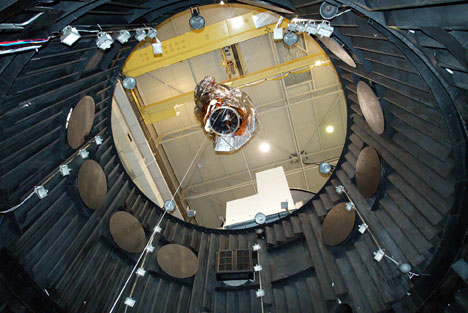
A crane lifts MESSENGER out of the thermal vacuum chamber at NASA’s Goddard Space Flight Center on Feb. 26, after the spacecraft completed five weeks of rigorous tests that showed it could withstand the wide range of hot and cold temperatures it will face on its journey to and mission around Mercury. Four of MESSENGER’s seven science instruments reside inside the “ring” on the bottom deck of the spacecraft, which also connects MESSENGER to its launch vehicle.
.

Wrapped in clouds of smoke, the Boeing Delta II rocket with its MESSENGER spacecraft on top climbs free as it lifts off on August 3, 2004, at 2:15:56 a.m. EDT from Launch Pad 17-B, Cape Canaveral Air Force Station. MESSENGER (MErcury Surface, Space ENvironment, GEochemistry, and Ranging) is on a seven-year, 4.9-billion-mile journey to the planet Mercury. The spacecraft will fly by Earth, Venus and Mercury several times, as well as circle the Sun 15 times, to burn off energy before making its final approach to the inner planet on March 18, 2011. MESSENGER was built for NASA by the Johns Hopkins University Applied Physics Laboratory in Laurel, Md.
Quelle: NASA
-
Update: 26.04.2015
-
MESSENGER Executes Last Orbit-Correction Maneuver, Prepares for Impact
MESSENGER mission controllers at the Johns Hopkins University Applied Physics Laboratory (APL) in Laurel, Md., conducted the last of six planned maneuvers on April 24 to raise the spacecraft's minimum altitude sufficiently to extend orbital operations and further delay the probe's inevitable impact onto Mercury's surface.
With the usable on-board fuel consumed, this maneuver expelled gaseous helium -- originally carried to pressurize the fuel, but re-purposed as a propellant. Without a means of boosting the spacecraft's altitude, the tug of the Sun's gravity will draw the craft in to impact the planet on April 30, at about 8,750 miles per hour (3.91 kilometers per second), creating a crater as wide as 52 feet (16 meters).
The previous maneuver, completed on April 14, raised MESSENGER's minimum altitude above Mercury from 6.5 kilometers (4.0 miles) to 13.3 kilometers (8.3 miles). But because of progressive changes in the orbit over time, the spacecraft's minimum altitude continued to decrease.
At the start of yesterday's maneuver, at 1:23 p.m. EDT, MESSENGER was in an orbit with a closest approach of 8.3 kilometers (5.1 miles) above the surface of Mercury. With a velocity change of 1.53 meters per second (3.43 miles per hour), the spacecraft's four largest monopropellant thrusters released gaseous helium to nudge the spacecraft to an orbit with a closest approach altitude of 18.2 kilometers (11.3miles).
Mission controllers at APL verified the start of the maneuver 9.4 minutes later, when the first signals indicating spacecraft thruster activity reached NASA's Deep Space Network (DSN) tracking station in Goldstone, California. This was the third MESSENGER maneuver designed to adjust the course of the spacecraft using just helium gas.
Since MESSENGER's launch in 2004, mission engineers have been working in lockstep with KinetX Aerospace to conduct such maneuvers. KinetX, based in Simi Valley, California, is the first commercial company to navigate any spacecraft to distant planetary bodies. The team processes radiometric tracking measurements from NASA's DSN antennas to perform orbit determination for MESSENGER.
The KinetX team was key to successfully navigating the spacecraft to arrive at the planet, and then for maintaining precise knowledge of the spacecraft's position while in orbit, including these last two months during MESSENGER's "hover campaign."
"Navigating a spacecraft so close to a planet's surface had never been attempted before, but it was a risk worth taking given mission success had already been met, and the novel science observation opportunities available only at such very low altitudes," said Bobby Williams, who leads the KinetX Space Navigation and Flight Dynamics group. "The MESSENGER mission presented new technical challenges for mission design and navigation that were successfully met through close cooperation and innovation of the APL and KinetX flight operations teams."
MESSENGER Principal Investigator Sean Solomon, Director of Columbia University's Lamont-Doherty Earth Observatory, commented on yesterday's maneuver on behalf of the project's Science Team as the end of the mission draws near.
"Operating a spacecraft in orbit about Mercury, where the probe is exposed to punishing heat from the Sun and the planet's dayside surface as well as the harsh radiation environment of the inner heliosphere, would be challenge enough," he said. "But MESSENGER's mission design, navigation, engineering, and spacecraft operations teams have done much more. They've fought off the relentless action of solar gravity, made the most of every usable gram of propellant, and devised novel ways to modify the spacecraft trajectory never before accomplished in deep space. They've extended the duration of MESSENGER's orbital observations by more than a factor of four over the original plan, and an amazing set of scientific discoveries has been enabled by their creative efforts. This latest maneuver is icing on a multi-tiered cake of spectacular accomplishment. The MESSENGER mission will soon end, but its legacy of scientific knowledge and technical innovation will endure for as long as we study the planets and explore the Solar System."
Quelle: NASA
.
Update: 30.04.2015
.
Overview of MESSENGER Spacecraft's Impact Region on Mercury
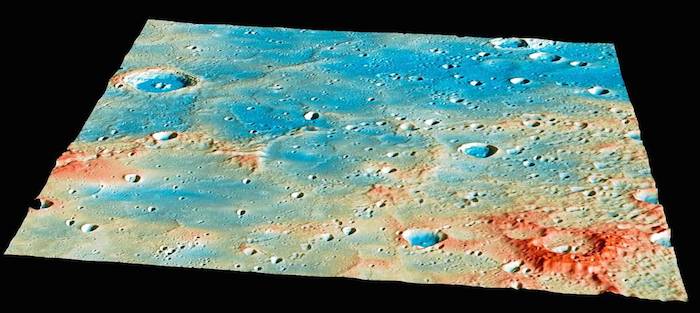
On April 30th, this region of Mercury's surface will have a new crater! Traveling at 3.91 kilometers per second (over 8,700 miles per hour), the MESSENGER spacecraft will collide with Mercury's surface, creating a crater estimated to be 16 meters (52 feet) in diameter.
The large, 400-kilometer-diameter (250-mile-diameter), impact basin "Shakespeare" occupies the bottom left quarter of this image, acquired by the Mercury Dual Imaging System (MDIS) and Mercury Laser Altimeter (MLA) instruments aboard the spacecraft. The image is coded by topography. The tallest regions are colored red and are roughly 3 kilometers (1.9 miles) higher than low-lying areas such as the floors of impact craters, colored blue. The large crater on the left side of the image is "Janacek," with a diameter of 48 kilometers (30 miles). The Shakespeare impact basin is filled with smooth plains material, likely due to extensive lava flooding in the past. As of 24 hours before the impact, the current best estimates predict that the spacecraft will strike a ridge slightly to the northeast of Shakespeare. View this image to see more details of the predicted impact site and time.
The MESSENGER spacecraft is the first ever to orbit the planet Mercury, and the spacecraft's seven scientific instruments and radio science investigation are unraveling the history and evolution of the Solar System's innermost planet. In the mission's more than four years of orbital operations, MESSENGER has acquired over 250,000 images and extensive other data sets. MESSENGER's highly successful orbital mission is about to come to an end, as the spacecraft runs out of propellant and the force of solar gravity causes it to impact the surface of Mercury on April 30, 2015.
Image Credit: NASA/Johns Hopkins University Applied Physics Laboratory/Carnegie Institution of Washington
Quelle: NASA
-
Update: 1.05.2015
-
Messenger's Mercury trip ends with a bang, and silence
Nasa's Messenger mission to Mercury has reached its explosive conclusion, after 10 years in space and four in orbit.
Now fully out of fuel, the spacecraft smashed into a region near Mercury's north pole, out of sight from Earth, at about 20:00 GMT on Thursday.
Mission scientists confirmed the impact minutes later, when the craft's next possible communication pass was silent.
Messenger reached Mercury in 2011 and far exceeded its primary mission plan of one year in orbit.
That mission ended with an inevitable collision: Messenger slammed into our Solar System's smallest planet at 8,750mph (14,000km/h) - covering 2.4 miles (3.9km) every second.
The impact will have completely obliterated this history-making craft. And it only happened because Mercury has no thick atmosphere to burn up incoming objects - the same reason its surface is so pock-marked by impact craters.
According to calculations, the 513kg, three-metre craft blasted a brand new crater the size of a tennis court. But that lasting monument is far too small to be visible from Earth.
"Today we bid a fond farewell to one of the most resilient and accomplished spacecraft ever to have explored our neighbouring planets," said Sean Solomon, Messenger's principal investigator.
"Our craft set a record for planetary flybys, spent more than four years in orbit about the planet closest to the Sun, and survived both punishing heat and extreme doses of radiation."
Messenger's fuel supply, half its weight at launch, was completely spent weeks ago but four final manoeuvres were conducted, to extend the flight as long as possible. These were accomplished by venting the helium gas normally used to pressurise actual rocket fuel into the thrusters.
The last of those manoeuvres took place on 28 April.
.
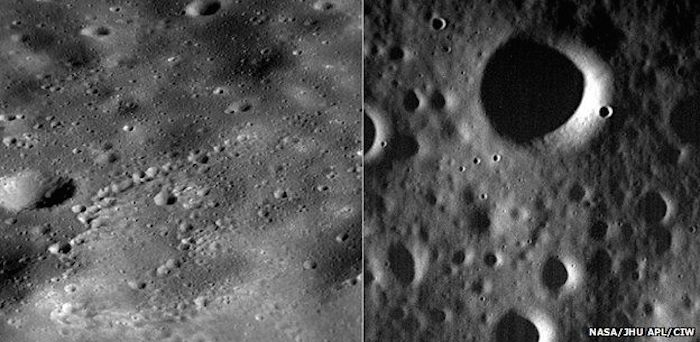
During its twice-extended mission, Messenger (MErcury Surface, Space ENvironment, GEochemistry, and Ranging) transformed our understanding of Mercury. It sent back more than 270,000 images and 10 terabytes of scientific measurements.
It found evidence for water ice hiding in the planet's shadowy polar craters, and discovered that Mercury's magnetic field is bizarrely off-centre, shifted along the planet's axis by 10% of its diameter.
Skimming the surface
For four years - and 4,105 circuits in total - Messenger traced a highly elliptical orbit around Mercury. It regularly drifted out to a distance of nearly twice the planet's diameter, before swinging to within 60 miles (96km) at closest approach.
To maintain this pattern in the face of interference from the Sun, it needed a blast of engine power every few months, which meant the mission faced an inevitable, violent end when the fuel ran out.
Quelle: BBC
-
MESSENGER's Last Mercury Photo Before Crashing is Crazy Close-Up
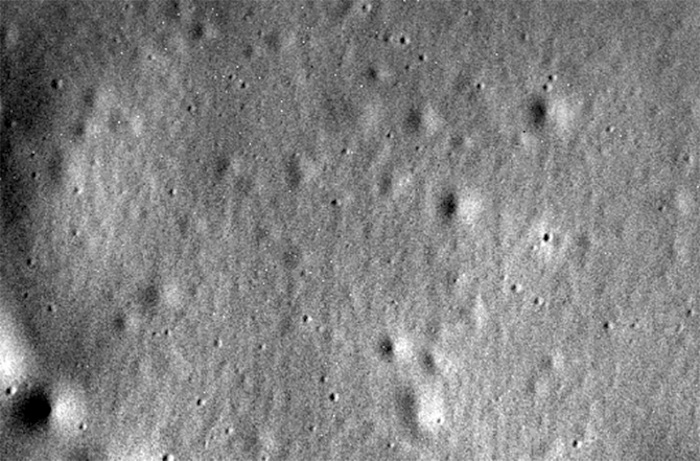
Today marked the end of NASA’s historic MErcury Surface, Space ENvironment, GEochemistry, and Ranging mission when the spacecraft slammed into the planet’s surface after running out of fuel. But as it zoomed danger-close to small planet’s surface at a mind-boggling 8,700 miles per hour, MESSENGER managed to beam one last look at the Mercurian landscape back to Earth.
Captured by the mission’s Narrow Angle Camera (NAC) of the Mercury Dual Imaging System (MDIS), this view spans only about 1 mile wide, with a resolution of 2.1 meters per pixel. In the view appears to be a relatively flat terrain dotted with small craters and smooth lumps.
Shortly after this photo was transmitted to NASA’s Deep Space Network (DNS) — a collaboration of global radio antennae keeping tabs on the space agency’s various robotic missions around the solar system — signal was lost and the probe is assumed to have completed its kamikaze plunge into a ridge to the northeast of a vast crater called “Shakespeare.”
Quelle: D-News
4388 Views
